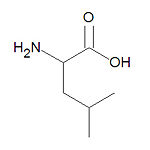Leucine: Difference between revisions
Jump to navigation
Jump to search

imported>David E. Volk (stub and structure) |
mNo edit summary |
||
| (One intermediate revision by one other user not shown) | |||
| Line 1: | Line 1: | ||
{{subpages}} | {{subpages}} | ||
{{Image|Leucine stick figure.jpg|right|150px|'''Leucine''', one of the twenty common amino acids.}} | |||
'''Leucine''', abbreviated as '''Leu''' or '''L''', is one of the twenty common [[amino acid]]s used by living organisms to build [[protein]]s. It is one of the non-polar, aliphatic, [[hydrophobic]] amino acids. In proteins, leucine is usually buried in a hydrophobic pocket within the protein structure sequestered away from the protein surface. Leucine is similar to the amino acids [[isoleucine]] and [[valine]] in both structure and function. | '''Leucine''', abbreviated as '''Leu''' or '''L''', is one of the twenty common [[amino acid]]s used by living organisms to build [[protein]]s. It is one of the non-polar, aliphatic, [[hydrophobic]] amino acids. In proteins, leucine is usually buried in a hydrophobic pocket within the protein structure sequestered away from the protein surface. Leucine is similar to the amino acids [[isoleucine]] and [[valine]] in both structure and function.[[Category:Suggestion Bot Tag]] | ||
Latest revision as of 11:00, 11 September 2024
Leucine, abbreviated as Leu or L, is one of the twenty common amino acids used by living organisms to build proteins. It is one of the non-polar, aliphatic, hydrophobic amino acids. In proteins, leucine is usually buried in a hydrophobic pocket within the protein structure sequestered away from the protein surface. Leucine is similar to the amino acids isoleucine and valine in both structure and function.
